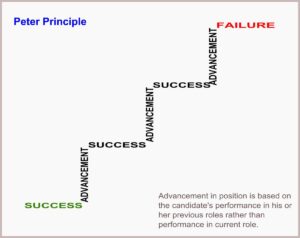You Cannot See a Label From Inside the Jar
The Peter Principle for Architects and Engineers reveals the following: Your firm is composed of Principals, Project Managers, and Staff Designers. A firm can get stuck when ownership doesn’t train project managers to become principals. Some firms feel that it costs too much to train project managers appropriately. But as Zig Ziglar once said, “It’s one thing not to train them if they leave. But what happens when you don’t train them, and they stay!!” In such a situation, the firm is forced to operate without “true” PMs, and principals will be bombarded with overwhelm.
When trained, Project Managers are like glass ceilings–they can only go so high until they learn to generate business to truly become principals.
Out of all firm levels, replacing a principal is typically the toughest position to replace. You need to be sure to nail down the right candidate with the right skill set. Transition is never easy, but it’s essential to hand over the reins only to the most qualified.
Managing the Firm, Not The Weeds of Projects
When the time comes, clarity of expectation is essential for the firm to move to future generations. This is a better option than just providing a zigzag of responsibilities to your PMs. As I’ve once heard, “Without clarity – You will miss the target every time.” Without clarity, the outcome will always remain unpredictable.
Years ago, Joe Fleisher of Ennead once told me, “We start training our people the moment they start their careers with us.” But the formula to determine the ideal expectations varies from firm to firm. Some principals want to do EVERYTHING. Some only want to do certain things. And some Principals only want to sell/ market.
The formula may not always be the same, but be sure to ask THESE QUESTIONS:
- What expectations should you have for project managers?
- What are principals responsible for?
- What tasks will be handed over to the project manager over the next year?
- What tasks are to be handed over to PMs within the next three and five years?
Ideally, project managers manage PROJECTS, while principals manage RELATIONSHIPS. The best project managers become principals. And these are the people that have unique personalities as well.
The Peter Principle for Architects and Engineers helps project managers to become principles.
In really large firms, principals show up to sell the project. Project managers are responsible for design and project financials–budget, receivable collections, budget management, etc. And at the end of the project, the Peter principle example shows up again to say, “Doesn’t this look great?” This is the IDEAL picture, but it can be elusive. The ultimate goal is to achieve as much firm consistency amongst its PMs as possible.

If the project manager only achieves the lowest rung–you have no succession plan–your firm will ultimately become obsolete and whither away. If PMs get to rung four, the firm has a chance to survive to the next generation but will probably flounder. In this scenario, it will be up to the third generation to re-instill an entrepreneurial spirit to give the firm a chance of survival.
The “gold standard” is step five for PMs. Step five leads to step six, where the best project managers become principals.
Like this article? Contact Us and let us know what you think about The Peter Principle for Architects and Engineers.
When you are ready, here are 5 ways I can help…
- Download your free A/E Consumer’s Guide. [Click Here]
- Would you like me or a member of my team to WOW your organization with a presentation? Reply to this email and put “Speak” in the subject line.
- Book a free 30 minute call to get to know us. [Click Here]
- Provide you with a professional liability proposal upon renewal. [Click Here]
- Subscribe to my YouTube channel.
973-564-9330
Steve@Whitehornfinancial.com


